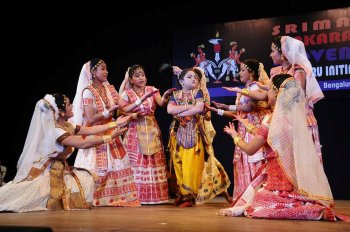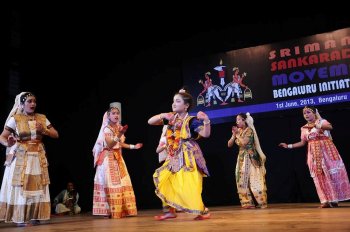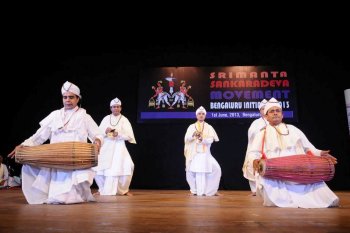
|   |

|   |
The Sattriya footprint in Bangalore - Satish Suri e-mail: satishism@yahoo.co.in Photos courtesy: Ghananil Phukan June 11, 2013 Sattriya dance has finally made its footfall in Bangalore. Under the auspices of the Srimanta Sankaradeva Movement Bengaluru Initiative a dance drama ‘Chordhora Jhumara’ in the Sattriya tradition was presented on 1st June at the Chowdiah Memorial Hall, Bangalore. Sattriya dance borne out of the living tradition created by the saint philosopher Srimanta Sankardeva in the 15th century in Assam was traditionally performed in Vaishnava monasteries. It has now come to the centre stage and is also classified as one of the eight classical dance forms of India. Victor Banerjee, the Brand Ambassador of The Sankaradeva Movement, spoke about the great journey Sankaradeva undertook more than 500 years ago to establish a philosophy relevant to the present time and created the Sattriya dance form that can be traced back directly to one individual as opposed to a set of people associated with the creation of other dance forms. 

Jhumura, a unique style of drama, was first introduced by Mahapurush Madhabdev, the most prominent disciple of Srimanta Sankaradeva. The drama revolves around the childhood pranks of Krishna, his attempt to steal butter in the house of a gopi. He refutes the charge and accuses the gopis of falsely implicating him and they are soon outwitted. Yashoda is worried and anxious about her son, desperately looks for him and finally breaks down. When she eventually locates him in the midst of the gopis, her joys knows no bounds. She admonishes the gopis and holds Krishna in her arms. Bhakti is the central theme of Sattriya. The narrative opens with the signature rhythmic play of the famous drum and cymbals (khol and taal) that Sankaradeva shaped. The Sutradhar then enters and plays a pivotal role, stringing together all the components, proclaims the theme, announces the entrance and exit of each character and elaborates on the theme. There was a certain fluidity and openness in establishing the narrative, through Krishna’s relationship with the gopis, the common place events surrounding them, the filial love of child Krishna for Yashoda and the vatsalya of Yashodha. The musical component enriched by a tonal quality with the playing of the khol (drum) and the taal (cymbals) accompanied by the violin and flute, complimented the movements of the dancers. There was very little verse in the musical composition. The simple and graceful costumes worn by the artistes added refinement to the presentation, coming out of the long standing tradition of the Sattras.  Rengani Mahanta as the child artiste essayed the role of Krishna, Dr. Mallika Kandali as Yashodha displayed her strength in abhinaya and Sarojini Bhaswa Mahanta displayed remarkable competence as the Sutradhar. The music ensemble consisting of Nityananda Deka and Durgamayee Borah (vocals) supported by Hari Saikia and Narayan Kalita (khol), Ananda Muktiar and Madan Saikia (taal), Hitesh Sarma (violin) and Bhupen Rajbanshi (flute) was sublime and melodic. The Bengaluru Initiative with its team of dedicated volunteers must be complimented for making this presentation possible. One will surely look forward to seeing the entire repertoire of Sattriya as its footfalls increase in the coming days. Satish Suri has been an ardent follower of dance and music for more than 40 years, starting with being on the committee of the International Music and Arts Society founded by Vijaya Devi, sister of the Late Maharaja of Mysore, Jayachamarajendra Wodeyar and now presently is treasurer of World Dance Alliance Karnataka Chapter. He has presented several artistes, both dancers and musicians, over the last 40 years. |